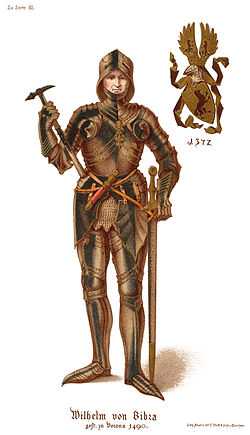Wilhelm von Bibra

Wilhelm von Bibra (1442–1490) (Eques auratus) was a Papal Emissary.
Papal Emissary
Wilhelm functioned as a Papal Emissary for both the archbishop of Cologne and Kaiser Friedrich. Wilhelm’s half brother, Prince Bishop Lorenz von Bibra of Würzburg, in 1487 wrote a letter of introduction to Pope Innocent VIII for Wilhelm who was being sent to the Vatican as emissary of Archbishop Herman of Cologne. As an emissary, he traveled to Rome three times: 1483, 1487, and 1490. By July 8, 1490, Wilhelm was referred to as "miles auratus" (a reference to him being a Knight of the Golden Spur). In 1490, Wilhelm became ill when returning from Rome as an emissary of the emperor Frederick III. He was a guest at the Palazzo of the countly Pellegrini family when he died August 28, 1490. Wilhelm's tomb stone is still to be seen in the Pellegrini Chapel of the Santa Anastasia in Verona. Originally, it was on the floor and was moved to the wall in summer of 1804.
von Bibra Family
Wilhelm was a member of the aristocratic Franconian von Bibra family which among its members were Wilhelm’s half brother, Lorenz von Bibra Prince-Bishop of Würzburg, Duke in Franconia, Conrad von Bibra, Prince-Bishop of Würzburg, Duke in Franconia (1490-1544), Heinrich von Bibra, Prince-Bishop, Prince-Abbot of Fulda (1711-1788) and Ernst von Bibra (1806-1878), naturalist and author.


Description of inscription on grave
- Nobilis et stren,. Doms. Gulielmus de Bibra
- Eques aureus, Ducatu Franciae Orientalis
- Oriundus, Sereniss. D. Frederici III◦ Caesoris
- victiss, et Massimiliani eius nati, incliti
- Romanorum Regis Consiliar ad S.D.N.
- Archiepiscp.) Innocentiu Pap. VIII◦
- Orator et Nuntius, atque Reverendiss.
- D. Hermani Archiepiscopi Coloniensis
- Principis Electoris Magister Curiae et
- consiliarius completa legatione ex Ro.
- Domus regreditur. Obiit in hac inclita
- Urbe Veronae die. S.S. August: anno 1490.
- Cuius anima requiescat in pace.
- In piedi ancora queste parole:
- Peregrinorum familia pietatis gratia nunc
- mihi soli in hoc sacello tu mulum
- concessit An. MLXXXX.
References
- Altfrankische Bilder 60. Jahrgang 1961, Universitaetsdruckerei H. Stuertz AG. Wuerzburg, p.4-5
- WILHELM FRHR. VON BIBRA, Geschicte der Familie der Freiherrn von Bibra, 1870;
- Wilhelm Freiherr von Bibra: Beiträge zur Familien Geschichte der Reichsfreiherrn von Bibra. (Vol. 2), 1882, Universitäts- und Landesbibliothek Düsseldorf, P. 251-269.
- WERNER WAGENHÖFER, Die Bibra: Studien und Materialien zur Genealogie und zur Besitzgeschichte einer fränkischen Niederadelsfamilie im Spätmittelalter, Verlag Degener & Co, 1998, 699 pages, ISBN 3-7686-9147-0;
External links
- http://vonbibra.net/WilhelmvonBibra.html Wilhelm von Bibra Page
- A Cyclopaedia of Costume Or Dictionary of Dress, Including Notices of Contemporaneous Fashions on the Continent: A general history of costume in Europe, Volume 2 of A Cyclopaedia of Costume Or Dictionary of Dress, Including Notices of Contemporaneous Fashions on the Continent: A General Chronological History of the Costumes of the Principal Countries of Europe, from the Commencement of the Christian Era to the Accession of George the Third, James Robinson Planché, Publisher Chatto and Windus, 1879, page 136
|